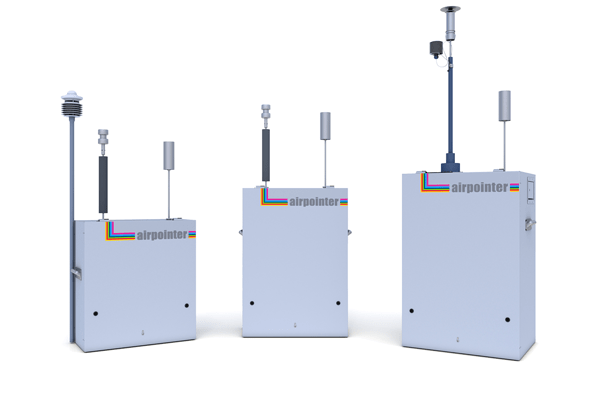
Airpointer®
The Airpointer® is a revolutionary, compact, and modular system for air quality monitoring. It is easy to install, cost effective to operate and easy to maintain. Its compact design enables it to be installed almost everywhere.
The Airpointer® offers a choice of U.S. EPA Federal Equivalent Method (FEM) analysis modules for monitoring the classic airborne pollutants (SO2, NO2/NOX, CO, O3, and PM). Further modules for other pollutant are available (H2S, VOCs, BTEX, etc.) and it operates additional external sensors (wind speed, wind direction, light intensity, GPS, traffic count, etc.).
The integrated data management system records the monitoring data from the Airpointer’s gas and particulate modules as well as various external third-party sensors. An internal web server enables data retrieval using any internet connection. A web browser interface allows for complete remote control of the unit, as well as display of data using easy to read graphics. All parameters can be displayed locally or online.
Its advanced and patented temperature management and energy management system reduces power consumption by 90% versus comparable stations, and the Airpointer® will be ready for operation within 30 minutes of initial start-up.
The Airpointer® is a unique and patented measuring device for multiple air quality environmental parameters (US 7,756,683).
Other Integrated Features
• Internal Zero/Span for automated quality control and precision
• Gas Sampling Inlet for continuous measurements of selective gases
• PM Sampling Inlet: for PM2.5, PM10 or TSP measurement depending on the configuration
• Long-Life Sample Pump
• Extended Lifetime Filter: A Teflon screen cylinder filter allowing for extended filter life
• Integrated data acquisition controller which outputs data in various user-accessible formats
Practical Applications:
• Oil and gas fence line configuration
• Other industrial configurations: steel mills, chemical plants, petrochemical, mining
• Community Field Reference tool for verifying small sensor networks
• Traffic tunnel and other near roadside configurations
• Military operations: researching and reporting air pollutants and visibility
• Airports: identifying pollution generated by aircrafts and ground traffic
• University and research institutions: accurate, reliable and verifiable air pollution measurements
• Ports and harbors: ship emissions



OLYMPUS DIGITAL CAMERA
